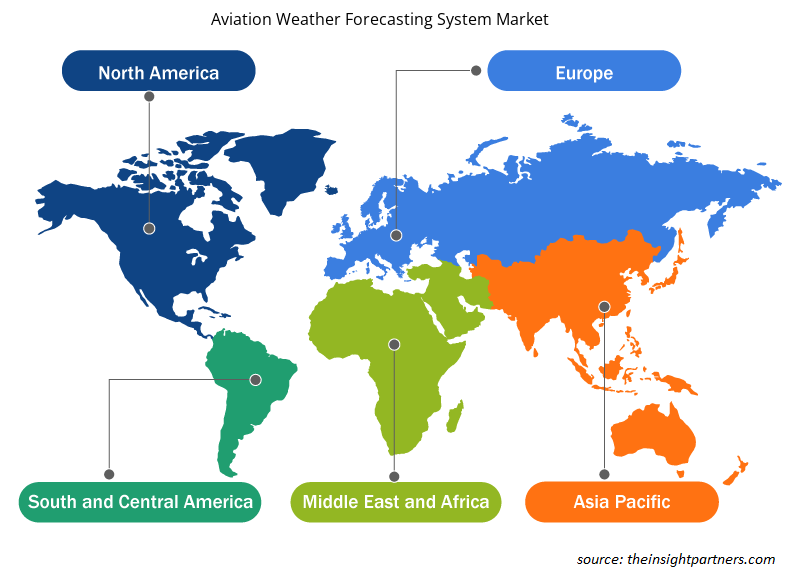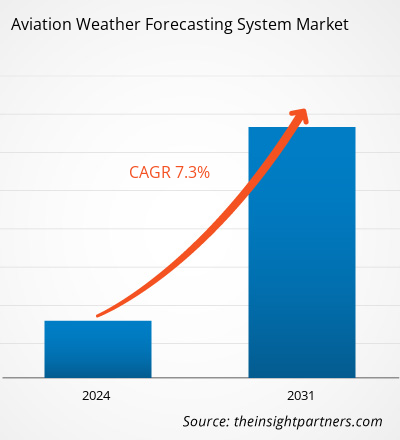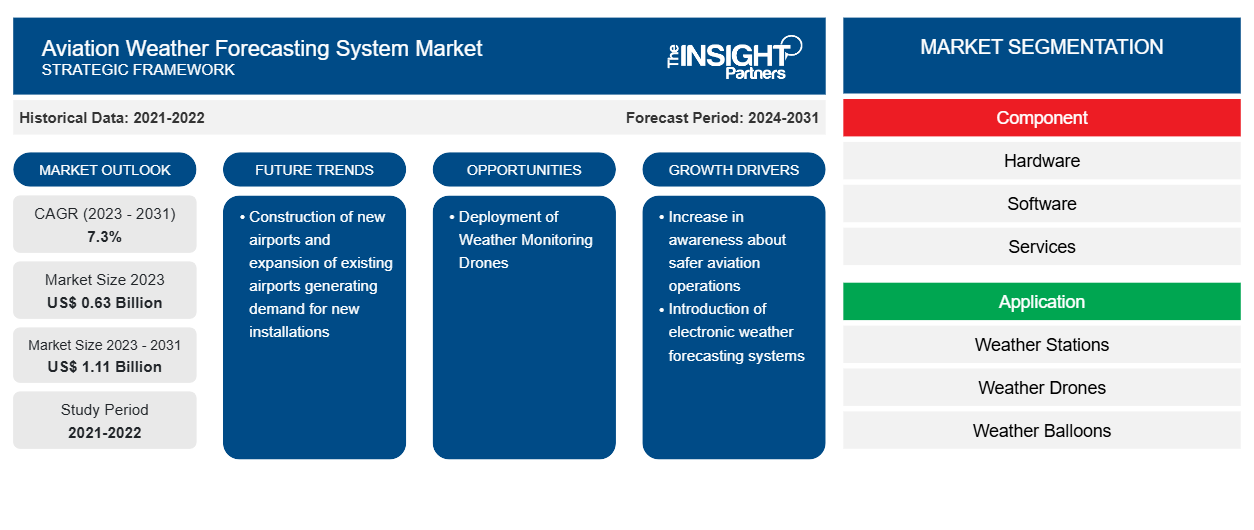Si prevede che la dimensione del mercato dei sistemi di previsione meteorologica per l'aviazione raggiungerà 1,11 miliardi di dollari entro il 2031, rispetto agli 0,63 miliardi di dollari del 2023. Si prevede che il mercato registrerà un CAGR del 7,3% nel periodo 2023-2031. La costruzione di nuovi aeroporti e l'espansione di aeroporti esistenti che generano domanda per nuove installazioni probabilmente rimarranno una tendenza chiave nel mercato.
Analisi di mercato del sistema di previsione meteorologica per l'aviazione
Alcuni dei principali attori che operano nel mercato globale dei sistemi di previsione meteorologica per l'aviazione sono Collins Aerospace, ENAV SpA, IBM Corporation, Vaisala e Campbell Scientific Inc. Il mercato è altamente consolidato con diversi attori di spicco che soddisfano la domanda nazionale e internazionale. Questi attori acquisiscono cumulativamente una quota maggiore nel mercato globale dei sistemi di previsione meteorologica per l'aviazione rispetto alle altre aziende, secondo lo studio di ricerca di mercato sui sistemi di previsione meteorologica per l'aviazione.
Panoramica del mercato dei sistemi di previsione meteorologica per l'aviazione
I player del sistema di previsioni meteo per l'aviazione includono sia produttori di hardware che fornitori di software che dipendono l'uno dall'altro. I produttori di hardware e i fornitori di software sono Collins Aerospace, IBM Corporation, Campbell Scientific Inc, Sutron, DTN, Spire Global, Universal Weather and Aviation Inc, Vaisala, Ubimet e molti altri. Il mercato del sistema di previsioni meteo per l'aviazione ha molti piccoli player impegnati nel business che detiene una quota significativa del mercato globale. I piccoli player sono anche coinvolti in attività di R&S per lo sviluppo di nuove tecnologie che stanno ulteriormente rafforzando le dimensioni del mercato nei prossimi anni. Queste organizzazioni nel corso degli anni hanno aumentato i loro investimenti nello sviluppo di nuovi e avanzati sistemi di previsioni meteo per l'aviazione in base alle crescenti esigenze dei clienti con l'aiuto degli enti normativi governativi. L'ente normativo governativo aiuta il sistema di previsioni meteo per l'aviazione sia i produttori di hardware che i fornitori di software fornendo il contratto all'aeroporto militare e agli aeroporti commerciali.
Personalizza questo report in base alle tue esigenze
Riceverai la personalizzazione gratuita di qualsiasi report, comprese parti di questo report, o analisi a livello nazionale, pacchetto dati Excel, oltre a usufruire di grandi offerte e sconti per start-up e università
- Scopri le principali tendenze di mercato in questo rapporto.Questo campione GRATUITO includerà analisi di dati che spaziano dalle tendenze di mercato alle stime e alle previsioni.
Driver e opportunità di mercato per i sistemi di previsione meteorologica per l'aviazione
Introduzione dei sistemi elettronici di previsione meteorologica
L'introduzione e l'adozione di sistemi elettronici correlati alle previsioni meteorologiche stanno spingendo i venditori del mercato a sviluppare prodotti innovativi e a soddisfare la crescente domanda. Inoltre, diversi aeroporti stanno prendendo iniziative per installare sistemi elettronici di monitoraggio meteorologico sulle loro piste e nei locali aeroportuali per ottenere operazioni più sicure in tutte le strutture. Ad esempio, a gennaio 2024, l'aeroporto di Salida-Harriet Alexander Field (KANK) in Colorado ha annunciato l'apertura e l'avvio delle operazioni del suo nuovo sistema meteorologico elettronico all'avanguardia che consente loro di condurre operazioni di atterraggio in modo più sicuro all'aeroporto e di avere un'idea migliore delle condizioni dell'aria in aeroporto.
Distribuzione di droni per il monitoraggio meteorologico
I droni meteorologici sono specificamente progettati per volare nello strato più basso dell'atmosfera terrestre (lo strato limite) e sono dotati di sensori per raccogliere informazioni su temperatura, vento, umidità, temporali e pressione atmosferica nell'atmosfera. L'impiego di droni per raccogliere dati meteorologici è uno dei principali fattori che si prevede genererà enormi opportunità per i venditori di mercato durante il periodo di previsione. Questi droni sono installati con sensori termodinamici che raccolgono i dati meteorologici come umidità, pressione e temperatura e li segnalano alle stazioni meteorologiche. I sistemi di previsione in tempo reale possono utilizzare questi dati negli aeroporti. Il sistema di previsione in tempo reale utilizza quindi i dati per fornire previsioni meteorologiche e aggiornamenti per gli ambienti del traffico aereo. Diverse organizzazioni stanno attualmente lavorando su sistemi di raccolta dati dei droni più efficienti per ottenere sistemi di monitoraggio meteorologico dei droni più affidabili che possono essere utilizzati per fornire dati più accurati e in tempo reale per i sistemi di previsione meteorologica in tutto il settore dell'aviazione.
Analisi della segmentazione del rapporto di mercato del sistema di previsione meteorologica per l'aviazione
I segmenti chiave che hanno contribuito alla derivazione dell'analisi di mercato dei sistemi di previsione meteorologica per l'aviazione sono i componenti, l'applicazione e il tipo di previsione.
- In base ai componenti, il mercato dei sistemi di previsione meteorologica per l'aviazione è segmentato in hardware, software e servizi. Il segmento hardware ha detenuto una quota di mercato maggiore nel 2023.
- In base all'applicazione, il mercato dei sistemi di previsione meteorologica per l'aviazione è segmentato in stazioni meteorologiche, droni meteorologici, palloni meteorologici e altri. Il segmento delle stazioni meteorologiche ha detenuto una quota di mercato maggiore nel 2023.
- In base al tipo di previsione, il mercato dei sistemi di previsione meteorologica per l'aviazione è segmentato in corto raggio, medio raggio, esteso raggio e lungo raggio. Il segmento a corto raggio ha detenuto una quota di mercato maggiore nel 2023.
Analisi della quota di mercato del sistema di previsione meteorologica per l'aviazione per area geografica
L'ambito geografico del rapporto di mercato sui sistemi di previsione meteorologica per l'aviazione è suddiviso principalmente in cinque regioni: Nord America, Europa, Asia Pacifico, Medio Oriente e Africa e Sud America.
Il Nord America ha dominato il mercato nel 2023, seguito dall'Europa e dalle regioni dell'Asia Pacifica. Inoltre, è probabile che anche l'Asia Pacifica assista al CAGR più elevato nei prossimi anni. Due dei paesi più popolosi nella regione dell'Asia Pacifica, ovvero Cina e India, hanno già annunciato i loro piani futuri per la costruzione di nuovi aeroporti. Ad esempio, nel 2023, il governo indiano ha annunciato i suoi piani per costruire 80 nuovi aeroporti nel paese entro la fine del 2025. Allo stesso modo, anche la Cina ha annunciato i suoi piani per costruire 216 nuovi aeroporti entro la fine del 2035. Si prevede che ciò guiderà ulteriormente l'installazione del mercato dei sistemi di previsione meteorologica per l'aviazione in tutta la regione dell'Asia Pacifica nei prossimi anni.
Approfondimenti regionali sul mercato dei sistemi di previsione meteorologica per l'aviazione
Le tendenze regionali e i fattori che influenzano il mercato dei sistemi di previsione meteorologica per l'aviazione durante il periodo di previsione sono stati ampiamente spiegati dagli analisti di Insight Partners. Questa sezione discute anche i segmenti e la geografia del mercato dei sistemi di previsione meteorologica per l'aviazione in Nord America, Europa, Asia Pacifico, Medio Oriente e Africa e America meridionale e centrale.

- Ottieni i dati specifici regionali per il mercato dei sistemi di previsione meteorologica per l'aviazione
Ambito del rapporto di mercato sui sistemi di previsione meteorologica per l'aviazione
| Attributo del report | Dettagli |
|---|---|
| Dimensioni del mercato nel 2023 | 0,63 miliardi di dollari USA |
| Dimensioni del mercato entro il 2031 | 1,11 miliardi di dollari USA |
| CAGR globale (2023-2031) | 7,3% |
| Dati storici | 2021-2022 |
| Periodo di previsione | 2024-2031 |
| Segmenti coperti | Per componente
|
| Regioni e Paesi coperti | America del Nord
|
| Leader di mercato e profili aziendali chiave |
|
Densità dei player del mercato del sistema di previsione meteorologica per l'aviazione: comprendere il suo impatto sulle dinamiche aziendali
Il mercato dei sistemi di previsione meteorologica per l'aviazione sta crescendo rapidamente, spinto dalla crescente domanda degli utenti finali dovuta a fattori quali l'evoluzione delle preferenze dei consumatori, i progressi tecnologici e una maggiore consapevolezza dei vantaggi del prodotto. Con l'aumento della domanda, le aziende stanno ampliando le loro offerte, innovando per soddisfare le esigenze dei consumatori e capitalizzando sulle tendenze emergenti, il che alimenta ulteriormente la crescita del mercato.
La densità degli operatori di mercato si riferisce alla distribuzione di aziende o società che operano in un particolare mercato o settore. Indica quanti concorrenti (operatori di mercato) sono presenti in un dato spazio di mercato in relazione alle sue dimensioni o al valore di mercato totale.
Le principali aziende che operano nel mercato dei sistemi di previsione meteorologica per l'aviazione sono:
- Campbell Scientific Inc
- Azienda aerospaziale Collins
- Società IBM
- Società Sutron
- Vaisala
- Meteo universale e aviazione Inc
Disclaimer : le aziende elencate sopra non sono classificate secondo un ordine particolare.

- Ottieni la panoramica dei principali attori del mercato dei sistemi di previsione meteorologica per l'aviazione
Notizie di mercato e sviluppi recenti del sistema di previsione meteorologica per l'aviazione
Il mercato dei sistemi di previsione meteorologica per l'aviazione viene valutato raccogliendo dati qualitativi e quantitativi dopo la ricerca primaria e secondaria, che include importanti pubblicazioni aziendali, dati associativi e database. Di seguito sono elencati alcuni degli sviluppi nel mercato dei sistemi di previsione meteorologica per l'aviazione:
- Una partnership tra il Met Office, FLYHT Aerospace Solutions Ltd. (TSX-V: FLY) (OTCQX: FLYLF) e Loganair, mira a migliorare l'accuratezza delle previsioni meteorologiche e la previsione di condizioni meteorologiche avverse localizzate nel Regno Unito, con benefici attesi per il settore dell'aviazione, come una pianificazione più efficiente delle rotte e il supporto agli obiettivi di riduzione delle emissioni di CO2. (Fonte: Met Office, comunicato stampa, agosto 2023)
- Empresa Argentina de Navegación Aérea ha annunciato il completamento delle operazioni di installazione di tre nuovi sistemi di osservazione meteorologica automatica (AWOS) negli aeroporti di San Miguel de Tucumán, San Salvador de Jujuy e Salta Argentina. (Fonte: Empresa Argentina de Navegación Aérea, comunicato stampa, gennaio 2022)
Copertura e risultati del rapporto di mercato sui sistemi di previsione meteorologica per l'aviazione
Il rapporto "Dimensioni e previsioni del mercato del sistema di previsione meteorologica per l'aviazione (2021-2031)" fornisce un'analisi dettagliata del mercato che copre le seguenti aree:
- Dimensioni del mercato dei sistemi di previsione meteorologica per l'aviazione e previsioni a livello globale, regionale e nazionale per tutti i segmenti di mercato chiave coperti dall'ambito
- Tendenze del mercato dei sistemi di previsione meteorologica per l'aviazione e dinamiche di mercato come driver, limitazioni e opportunità chiave
- Analisi dettagliata delle cinque forze di Porter
- Analisi di mercato del sistema di previsione meteorologica per l'aviazione che copre le principali tendenze del mercato, il quadro globale e regionale, i principali attori, le normative e i recenti sviluppi del mercato
- Analisi del panorama industriale e della concorrenza che copre la concentrazione del mercato, l'analisi della mappa di calore, i principali attori e gli sviluppi recenti per il mercato dei sistemi di previsione meteorologica per l'aviazione
- Profili aziendali dettagliati
- Analisi storica (2 anni), anno base, previsione (7 anni) con CAGR
- Analisi PEST e SWOT
- Valore/volume delle dimensioni del mercato - Globale, Regionale, Nazionale
- Industria e panorama competitivo
- Set di dati Excel
Report recenti
Testimonianze
Motivo dell'acquisto
- Processo decisionale informato
- Comprensione delle dinamiche di mercato
- Analisi competitiva
- Analisi dei clienti
- Previsioni di mercato
- Mitigazione del rischio
- Pianificazione strategica
- Giustificazione degli investimenti
- Identificazione dei mercati emergenti
- Miglioramento delle strategie di marketing
- Aumento dell'efficienza operativa
- Allineamento alle tendenze normative





















 Ottieni un campione gratuito per - Mercato dei sistemi di previsione meteorologica per l'aviazione
Ottieni un campione gratuito per - Mercato dei sistemi di previsione meteorologica per l'aviazione